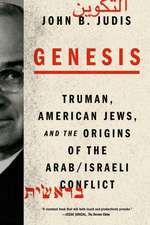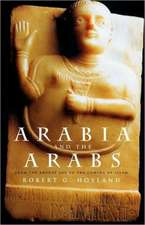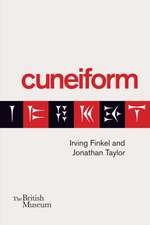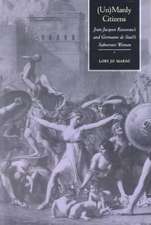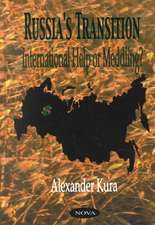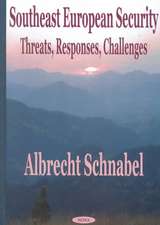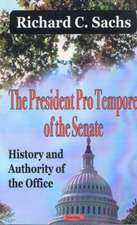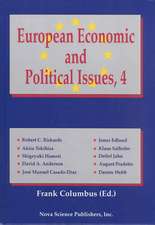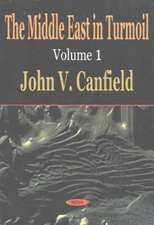Politics and Change in the Middle East: 10e
Autor Roy Anderson, Robert Seibert, Jon Wagneren Limba Engleză Paperback – 27 feb 2011
| Toate formatele și edițiile | Preț | Express |
|---|---|---|
| Paperback (1) | 678.96 lei 43-57 zile | |
| Taylor & Francis – 27 feb 2011 | 678.96 lei 43-57 zile | |
| Hardback (1) | 1014.74 lei 43-57 zile | |
| Taylor & Francis – 30 iun 2017 | 1014.74 lei 43-57 zile |
Preț: 678.96 lei
Preț vechi: 798.78 lei
-15% Nou
Puncte Express: 1018
Preț estimativ în valută:
129.92€ • 135.99$ • 108.13£
129.92€ • 135.99$ • 108.13£
Carte tipărită la comandă
Livrare economică 31 martie-14 aprilie
Preluare comenzi: 021 569.72.76
Specificații
ISBN-13: 9780205082391
ISBN-10: 0205082394
Pagini: 432
Dimensiuni: 189 x 246 x 30 mm
Greutate: 0.7 kg
Ediția:Revised
Editura: Taylor & Francis
Colecția Routledge
Locul publicării:Oxford, United Kingdom
ISBN-10: 0205082394
Pagini: 432
Dimensiuni: 189 x 246 x 30 mm
Greutate: 0.7 kg
Ediția:Revised
Editura: Taylor & Francis
Colecția Routledge
Locul publicării:Oxford, United Kingdom
Public țintă
UndergraduateCuprins
Detailed Contents -- Introduction -- Chapter 1 Traditional Cultures of the Middle East: The -- of Civilization and Politics -- Chapter 2 The Foundations of Islam -- Chapter 3 The Political Legacy of Islam, 632–1800 C.E. -- Chapter 4 Western Imperialism, 1800–1914 C.E. -- Chapter 5 The Rise of the State System, 1914–1950 -- Chapter 6 The Drive for Self-Determination, 1950–1990 -- Chapter 7 Turning Points -- Chapter 8 The Politics of Religion, Culture, and Social Life -- Chapter 9 Political Elites -- Chapter 10 Political Leadership in the Contemporary East -- Chapter 11 The Economic Setting -- Chapter 12 International Relations in the Middle -- 1945–1990 -- Chapter 13 International Relations in the Middle -- 1945–1990: The Regional Actors -- Chapter 14 The Middle East and the Changing -- Order: 1991–2001 -- Chapter 15 Did 9 /11 Change Everything? -- Glossary -- Index. Preface -- BRIEF CONTENTS -- INTRODUCTION -- Politics and Conflict -- Approaches to Social Change -- Chapter 1 TRADITIONAL CULTURES OF THE MIDDLE -- THE CRADLE OF CIVILIZATION AND POLITICS -- Foundations of Social Diversity -- Ecological Diversity -- Nomads -- Peasants and Urbanites -- Ethnic and Religious Diversity -- Descent, Occupation, and Social Stratification -- The Patchwork of Pluralism: Two Historical Examples -- Unity in Diversity -- Family, Kinship, and Marriage -- Religion -- Chapter 2 THE FOUNDATIONS OF ISLAM -- Central Beliefs of Islam -- The Five Pillars of Islam -- The Koran and the Hadith -- The Ulema -- Pre-Islamic Arab Ethics -- The Social Setting of Mecca -- The Confessional Religions -- Muhammad’s Ministry -- The Hijira -- The Koran’s Social Regulations -- The Spread of Islam -- Jihad and the Djimmi System -- Five Popular Misconceptions about Islam -- Islam as an Exotic Religion -- Islam as a Militant Religion -- Islam as an Intolerant Religion -- Islam as an Ultraconservative Religion -- Islam as a Sexist Religion -- Conclusion -- Chapter 3 THE POLITICAL LEGACY OF -- 632–1800 C.E. -- The Establishment of the Islamic State -- The Golden Age of the Caliphate -- Mongol Destruction and the Rebirth of the Empire -- The Ottoman Empire -- Growth and Decline in the Islamic State -- Legitimacy in Government -- The Political Role of the Ulema -- The Sharia Law -- The Shia -- Sufism -- Islam and Radical Politics -- The Kharijites -- Ismailis and Qarmatians -- The Mahdi -- Twelver Shiism -- The Muwahhidun Movement -- Diversity in Islamic Political Thought -- Chapter 4 WESTERN IMPERIALISM, 1800–1914 C.E. -- Setting the Stage -- The Ottomans -- Tanzimat Period (1839–1876) -- Egypt -- The Levant -- The Arabian Peninsula -- Iran -- Qajar Dynasty -- Conclusion -- Chapter 5 THE RISE OF THE STATE SYSTEM, 1914–1950 -- The McMahon–Husein Correspondence -- The Balfour Declaration -- World Zionist Organization -- The Mandates -- Syria and Lebanon -- Iraq and Transjordan -- Egypt -- Wafd Party and Muslim Brotherhood -- Egypt after World War II -- Saudi Arabia -- Turkey and Iran -- Turkey -- Iran -- From Palestine to Israel -- Conclusion -- Chapter 6 THE DRIVE FOR -- 1950–1990 -- Arab Nationalism -- Suez Canal Crisis and the Israeli War (1956) -- Syria -- The United Arab Republic -- Jordan, Lebanon, and Iraq -- Iran, the Gulf States, and Petroleum -- Iranian Revolution -- Iranian Revolutionary Government -- Iraq–Iran War: 1980–1988 -- Saudi Arabia’s Political Stability -- Yemen -- Gulf Cooperation Council -- Israel -- Political Setting -- Social Setting -- Israel and the Border States -- The 1956 Arab-Israeli War -- The 1967 Arab-Israeli War -- The 1973 Arab-Israeli War -- The 1982 Invasion of Lebanon -- The Palestinians and the 1988 Uprising -- The First Intifadah -- Conclusion -- Chapter 7 TURNING POINTS -- Circa 1990 -- Circa 2000 -- Circa 2010 -- Globalization -- Arab Nationalism -- International Organizations -- Economic Liberalization -- Political Islam -- Occupation of Iraq -- Political Legitimacy in the Gulf -- From Oslo to Jerusalem to Gaza -- Conclusion -- Chapter 8 THE POLITICS OF RELIGION, -- AND SOCIAL LIFE -- The Politics of Culture -- Politics of Culture in Islamic History -- Colonialism and Cultural Politics -- The Contemporary Politics of Islam -- Turkey: Radical Westernization and the Durability of Islam -- Egypt: The Labyrinth of Possibilities -- Saudi Arabia -- Iran and the Islamic Republic -- The Islamic Republic -- Sexual Politics -- Sexual Equality in Islam: The Modernist Interpretation -- Sexual Inequality in Islamic Tradition -- Struggle for Reform -- Women in the Islamic Revival -- Conclusion -- Chapter 9 POLITICAL ELITES -- Traditional, Transitional, and Technically Modernizing Elites -- Traditional Elites -- Transitional Elites -- IRAN -- SAUDI ARABIA -- KUWAIT -- BAHRAIN -- LIBYA -- JORDAN -- GULF EMIRATES -- Modern Elites -- TURKEY -- EGYPT -- SYRIA -- IRAQ -- LEBANON -- ISRAEL -- Conclusion -- Chapter 10 POLITICAL LEADERSHIP IN THE -- MIDDLE EAST -- Traditional Leadership -- King Farouk of Egypt -- Charismatic Leadership -- Gamal Abdel Nasser -- Modern Bureaucratic Leadership -- Anwar Sadat and Hosni Mubarak -- Consequences of Leadership Styles -- Traditional States -- Modern Bureaucratic States -- Charismatic Rule -- Ayatollah Ruhollah Khomeini -- Colonel Muammar Qadaffi -- Conclusion -- Chapter 11 THE ECONOMIC SETTING -- Economic Record -- Organization of Economic Activity -- Islamic Economics -- Economic Liberalization -- TURKEY -- IRAN -- Liberalization and Globalization -- Land Distribution Policies -- Turkey -- Egypt -- Syria -- Libya, Iraq, and Iran -- Agricultural Policies -- Water -- Population -- Migration -- Urbanization -- Employment -- Industry -- Petroleum -- Early Years -- World War II to 1970 -- OPEC Revolution -- Conclusion -- Chapter 12 INTERNATIONAL RELATIONS IN THE MIDDLE -- 1945–1990 -- The Great-Power System and The Middle East -- U.S. Foreign Policy -- Phase I -- Phase II -- INTERVENTIONS IN IRAN -- SUEZ WAR -- LEBANON CRISIS OF 1958 -- Phase III -- Soviet Foreign Policy -- Britain and France -- China and Japan -- Conclusion -- Chapter 13 INTERNATIONAL RELATIONS IN THE MIDDLE -- 1945–1990: THE REGIONAL ACTORS -- Palestinian International Action -- OPEC and Islam -- Nuclear Arms and Regional Politics -- Foreign Policies of Egypt, Saudi Arabia, Iran, and Israel -- Egyptian Foreign Policy -- EGYPTIAN FOREIGN POLICY UNDER SADAT AND MUBARAK -- Saudi Arabian Foreign Policy -- Iranian Foreign Policy -- FOREIGN POLICY OF THE IRANIAN REVOLUTION -- Israeli Foreign Policy -- Conclusion -- Chapter 14 THE MIDDLE EAST AND THE -- INTERNATIONAL ORDER: 1991–2001 -- Dimensions of the Emerging International Order -- The Middle East in the Emerging International Order -- Iraq–Kuwait Crisis -- Multinational Actors in the Conflict -- Desert Storm -- The Middle East at the End of Desert Storm -- Desert Storm as Indicator of New -- Realities -- The Arabs and the Israelis -- From Jerusalem to Oslo -- Superpowers and Great Powers -- Middle Eastern States -- Egypt -- Saudi Arabia -- Other Gulf States -- Syria -- Lebanon -- Iran -- Turkey -- Algeria, Morocco, and Tunisia -- Libya -- Israel -- Conclusion -- The View from 2000 -- Chapter 15 DID 9 /11 CHANGE EVERYTHING? -- The Reemergence of Iraq -- Two Coalitions -- The Middle East Quartet -- Regional Actors -- World Public Opinion -- War -- Perceptions -- A New Decade -- Elections in Israel -- Elections in Iran -- Elections in Iraq -- Regional Politics -- Turkey -- Saudi Arabia -- GCC -- Egypt -- Syria -- Jordan -- Iraq -- A Clash of Civilizations? -- Conclusion -- Glossary -- Index
Recenzii
“This exceptional text, which is popular amongst instructors and students alike, contains reliable and well-presented information about the Middle East. Its excellent framework will help undergraduates better understand contemporary developments in the region by examining its history and culture, as well as the impact of Islam, colonialism, and globalization.”–Anca Turcu, University of Central Florida
Descriere
A longtime bestseller, Politics and Change in the Middle East employs a multidisciplinary approach to comprehensively and evenhandedly study the region’s past, present, and future. Through politics, economics, culture, and history, this text offers a rugged analytical framework that familiarizes students with the Middle East.




